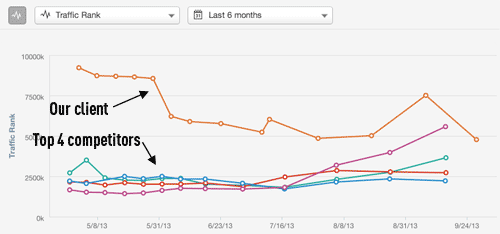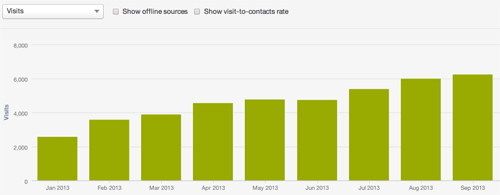Want to improve your company's search engine optimization (SEO)? Start a business blog!
Our client, a manufacturer, did, and their website traffic from search engines is up 75%. Let's take a look at what we did to get those results.
The Situation
Our client's website was in rough shape prior to a 2011 website redesign. The new website was visible in search engines, but only for the products and services that the company decided to include on their website. While they saw a spike in website traffic when the website re-launched in 2011, visits from search engines plateaued because the website wasn't updated on a regular basis.
After a website assessment and competitive report revealed that their competitors were getting more website visitors each month, we set a goal to close the gap within 12 months.
The Solution -- Business Blogging
In January of 2013, our client decided to be more aggressive with internet marketing, even though they were skeptical of the results they might get from the campaign. The focus was on creating content for the website on a regular basis by writing a business blog.
Because the company didn't feel comfortable writing the blog in house, we were called on to develop a strategic content marketing plan. The plan included a list of blog topics that combined the company's deep expertise in manufacturing their product with keywords that people were using to find similar products. This blog topic list was generated in partnership with their outside sales team.
Alongside the blog post topics were ideas for "premium content" that blog readers could download by supplying some basic contact information.
Over the course of the last several months, we've written 6 blog posts per month and posted them to their website.
The Results
The following graph shows a website traffic rank graph with our client (in orange) and their top 4 competitors. Note below that lower numbers are better (it's a ranking, after all), so there was a significant gap between our client's website traffic and their competitors.
Also note that no other substantive changes were made to their website. The only thing that changed over the 6 month period in the graph was that new blog posts were added regularly.
Below is a traffic rank graph of our client's website and their top 4 competitors. You can see the downward trend in traffic rank (which is a good thing), meaning that their website has seen an increasing number of visitors over the last 6 months.

Blogging, over time, has really helped our client close the gap with their competitors.
So what impact has this had on organic (non-paid) website traffic from search engines? The graph below shows an increase of 75% (the first month has only partial traffic data).
In addition to the increase, the uptick in traffic shows no signs of slowing down. The client has improved their competitive position in terms of website traffic.
This graph shows actual traffic from search engines (not paid clicks) from January 2013 - September 2013.

We found that this new website traffic was sales qualified, as well. Many of the new visitors were ready to engage the company to get quotes and buy their products. Business blogging netted the client a 216% increase in business leads. We were able to measure closed business from the internet marketing campaign through integration with the client's CRM, and the client made $9 in revenue for each dollar spent on their marketing campaign.
Key Takeaways and Some Advice
Results like what we saw with this client aren't out of the norm, but don't happen by accident. In order to increase your website traffic, leads, and ultimately, new business, you have to have a solid plan.
- You first need to carefully research your customer. Who are they, what do they care about, and what needs do they have? We do this by creating customer personas, but in the end, you have to write for a particular audience to get results.
- Blogging, even for "boring" industries, really works! Talk to your sales people and get them to jot down a list of things that customers routinely ask them. This will help you generate a nice list of blog topics.
- Want to generate more leads with your business blog? Include a call to action at the end to encourage people to take the next step.







